For all the advancements made in fish tank filter systems over the last couple of decades, I’m surprised at how little undergravel filters have changed. They were once the only option for small tanks, but modern power systems offer better filtration at a similar price. What are the ramifications of using undergravel filters vs power filters?
Undergravel Filter VS Power Filter in Aquarium
Undergravel Filter

Mode of Operation
Air Pump
Filtering Capabilities
Mostly Biological Filtration
Set-up
Installed at the time of set-up and prior to adding substrate
Advantages
Inexpensive
Easy to operate
Ideal for 30-gallon and underplanted/aquascaped aquariums with few fish
Disadvantages
Not ideal for debris removal or water purification
Limits substrate options
Only fit in some standard-sized tanks
Harder to install and maintain
Not ideal for tanks with moderate-to-high numbers of fish
Female Angelfish
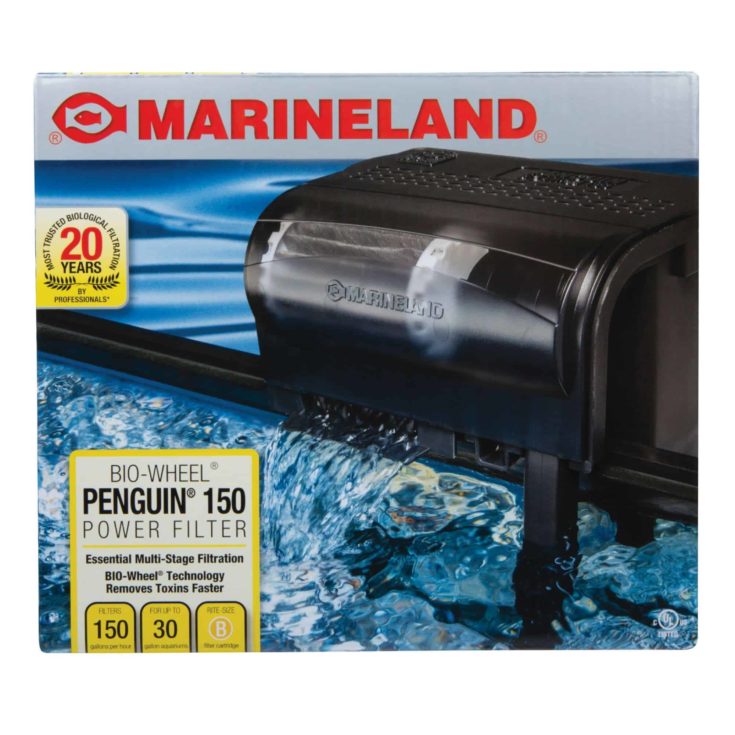
Mode of Operation
Electric motor/impeller
Filtering Capabilities
Robust Mechanical and Chemical filtration
Set-up
Easy to install on the back or side of new and existing tanks
Advantages
Comes in a variety of sizes and price points
Fits on or in most styles of aquarium, including custom tanks
Media mix is customizable
Easy to access and relocate if needed
Comes in budget and premium models
Ideal for planted and fish-only community tanks 2.5 gallons and up
Disadvantages
Slightly more expensive to buy and maintain
Biological filtration is limited
More complicated to operate
What’s The Difference Between Undergravel Filters vs Power Filters?
Undergravel filters are inexpensive air-pump-driven devices that primarily offer biological filtration via the good bacteria in your substrate. Power filters have electric motors and are more robust and efficient. They offer customizable mixes of mechanical and chemical filtration media, and some have biological stages too.
Power filters are nearly always superior to undergravel systems in their filtering abilities. Undergravels don’t do a great job at removing debris (mechanical filtration) or purifying the water (chemical filtration), and their main benefit is to draw debris into the substrate where they break down biologically.
What is an Undergravel Filter?
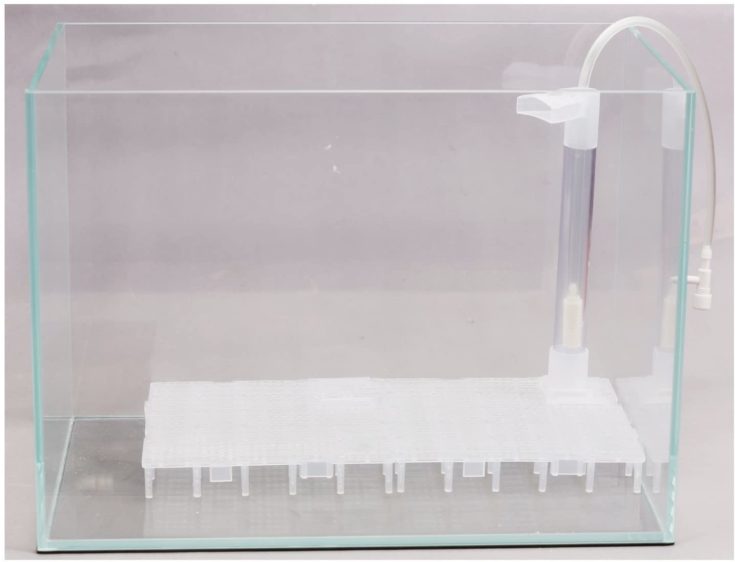
Undergravel systems work by using your substrate as their primary filter media. They typically include: plastic screens, plastic lift tubes and some pre-filled replaceable media cartridges. To assemble, attach the lift tubes to the screen and clip the cartridges to the end of the lift tubes.
To set-up an undergravel filter in your fish tank, you’ll need an empty aquarium, thin plastic aquarium tubing, and an appropriate air pump:
- Place the screen and lift tubes in the bottom of the empty tank.
- Cover the screen with a couple of inches of coarse gravel.
- Use plastic tubing to connect the filter to your air pump.
- Fill the tank with dechlorinated water.
- Plug the air pump in and the filter should start bubbling.
How Do Undergravel Filtration Systems Work?
Undergravel filters mainly provide biological filtration from the good bacteria in your substrate, which turn debris into plant food as part of the Nitrogen Cycle in your tank:
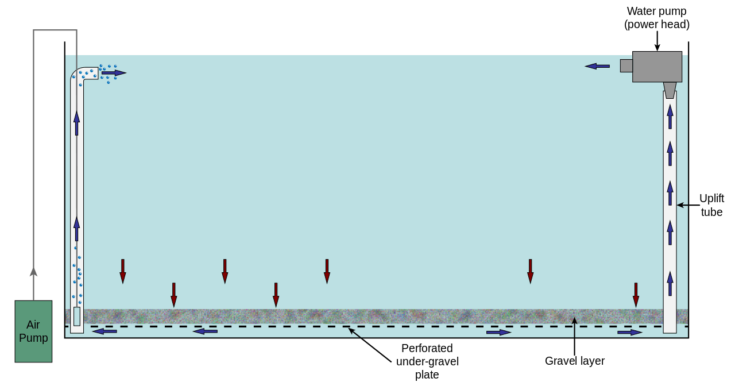
- The air pump generates suction, which pulls dirty water through the substrate and screen to the very bottom of your tank.
- The water goes up the lift tube and through the media cartridge, where it mixes with air and bubbles back into your tank.
- Large debris get trapped in the substrate and are eventually consumed by bacteria.
- Finer particles collect under the screen and form a matrix of biofilm, but some also flow up the lift tube and may be trapped in the cartridge.
Should I Use an Undergravel Filtration System: Pros and Cons
These filters are cheap and available in a range of sizes that fit standard-sized tanks from 10 to 55-gallons. They work well for small planted tanks, since debris decaying in and under the substrate provides nutrients your plants can use. They also act similarly to air stones and oxygenate your aquarium water.
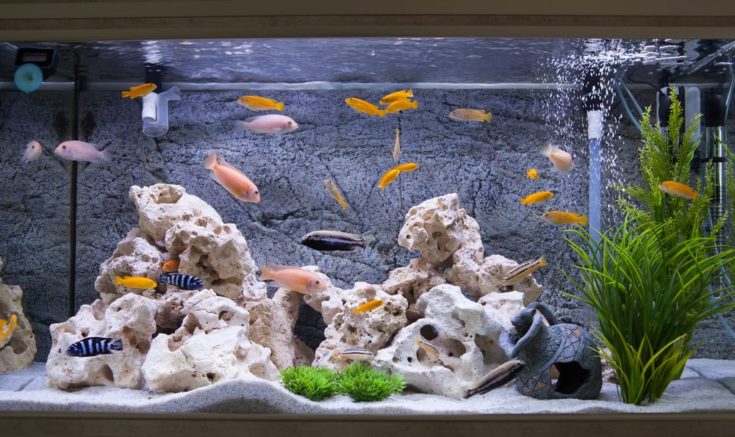
But they are less-than-ideal as a stand-alone filter for most tanks and especially those with moderate to high populations of fish:
- While undergravels can provide some mechanical and chemical filtration via the cartridges, it’s very limited, since they can’t hold much media.
- The screens limit the type of substrate you can use; fine sands and soils would fall through the gaps in the screen.
- You can’t bury the screens too deeply or the air pump and filter won’t work.
- It can take a few months for bacteria to become established in a new tank, so your filter may not be very effective initially.
- The filter isn’t adjustable once it’s in place, and you’ll have to break your tank down once a year to clean the biofilm sludge from under the filter’s screen.
What Are Power Filters?
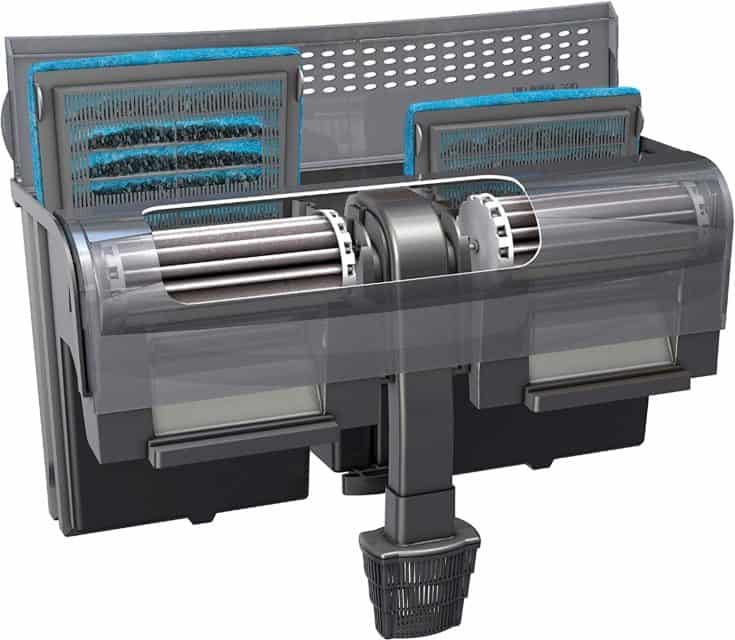
Power systems hang on or inside your tank and use electric motors to push water through the filtration stages inside the main compartment. They collect and remove debris and purify water using filter media, and some also offer biological filtration. They are ideal stand-alone filters for tanks from 2.5 gallons to 55-gallons.
These filters are ready-to-go right out of the box and come with everything you need to install and use them:
- Unbox the filter and check that the motor and impeller are in place and the compartment is clear of debris.
- Rinse your filter media in tap water.
- Slide the cartridges, sponges or media baskets into place inside the compartment.
- Hang your filter on the back of the tank or place it securely inside.
- Prime the impeller with water (if needed) and plug the filter in, and it should start right up.
Types of Power Filtration
There are two main types of power filtration systems. For nano tanks and small fish bowls, you can use a small internal power system that sits or hangs inside the aquarium. For larger set-ups, the robust and classic Hang-on-Back or HOB filter is one of the best power options.
How Do Power Filtration Systems Work?
HOB filters are more powerful than the smaller internal options, since they pump water out of your tank against gravity, but both styles work in similar fashions. The motor turns the impeller, which pulls water up the intake tube and sends it through the filtration stages. Clean water flows back into the tank via the outflow vent.
Large debris are caught by the filter pads inside the first stage, while pieces of carbon, ammonia chips, or bio-media in the other stages absorb or break-down toxins. Water polishing sponges may remove microscopic debris as well, leaving your water sparkling clear and smelling fresh.
Should I Use a Power Filtration System: Pros and Cons
Power systems are much more effective at removing debris and toxins from your water than the undergravel options, and they are a lot easier to maintain:
- They’ll reduce the frequency of your water changes and lower the amount of maintenance you have to perform.
- They are adjustable and can be removed easily for cleaning or relocation.
- The media in HOB-style filters remain accessible while the filter is operating and you won’t even have to reach into the water to change them.
- They can be used in planted tanks and for highly-stocked fish communities.
- Media mix used inside is customizable to the needs of your specific set-up.
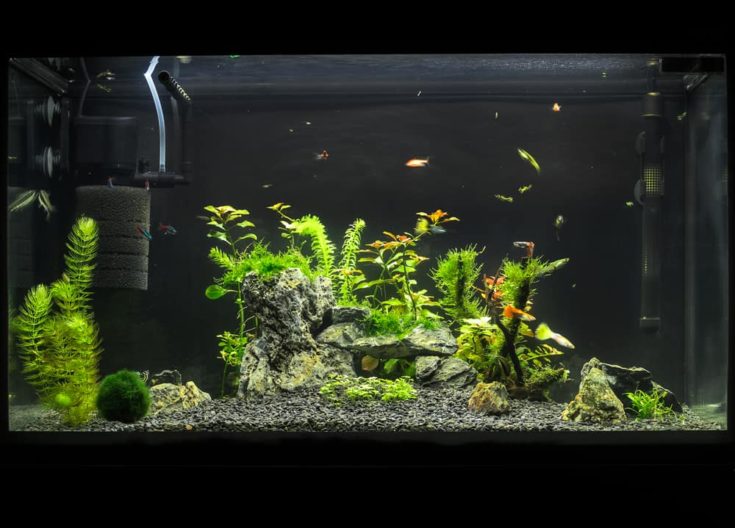
The main disadvantage of power systems compared to undergravels is that they don’t provide as much biological filtration, and they may not circulate water to every corner of your tank. Large aquariums usually require more than one filtration system.
Which is Better: Undergravel or Power Filtration System?
Now that you know how they work, let’s consider the implications of installing these filters and compare how they perform in your tank.
Filtering Capabilities
Power systems are better at collecting and removing debris from your tank, and offer more water purification than an undergravel system. Premium models may also have built-in bio-stages, like wheels or outflow sponges, and all types allow customizable mixes of media. Undergravel systems are ideal for feeding plants, but less useful for removing large debris or purifying water.
Set-Up and Ease-of-Use
Undergravel filters are easy to use, and there’s not much to fuss with other than changing the cartridges. They’re harder to install, because you can’t add one to an established tank without breaking it down to a bare bottom. Once they’re in place, you can’t easily make adjustments, and you’ll have to aquascape around the lift tubes.
Power filters are easy to set-up and relocate on demand, and you’ll have a lot of options when it comes to location and the filter media. Once in place, however, a power filter requires more attention. Since they usually hang outside your tank, there’s always the possibility they could spring a leak.
Maintenance
Undergravel systems are easy to maintain monthly but they are a beast when it comes to yearly cleaning. They stop working if you don’t clean out the build-up of biofilm under the screen. They also won’t spare you any of your weekly water changes. Large debris like fish poop and dead leaves collect on top of the substrate and need to be vacuumed out.
From a maintenance standpoint, even the weaker internal filters are superior to the undergravels because you can always remove them for cleaning. While it’s a good idea to check your HOB daily to look for leaks or clogged media, they are much easier to maintain long term than undergravels.
Price

While undergravel systems are prized for their cheapness, the truth is that you can get a modern power filter for about the same cost once you factor in the air pump.
If you’re on a tight budget, you may be better off with a power filter, since it will protect your fish and tank better in the long term.
Using Undergravel and Power Filters Together
If you install an undergravel system and find it’s not enough to keep your tank clean, you can always add another filter to pick up the slack. In fact, combining an undergravel with a power system is a great way to get superb filtration in a large community tank! You’d have mechanical, chemical and biological filtration covered!
Conclusion
These days, it makes a lot more sense to invest in a power system rather than an undergravel if you’re looking for a stand-alone filter. They are similar in price, but a HOB or internal filter will provide much more filtration bang for your buck.
Frankly, most folks who start with undergravels get sick of having to vacuum debris out every week, so save yourself the labor and get a power filter. You could also use them together in a planted or aquascaped aquarium.
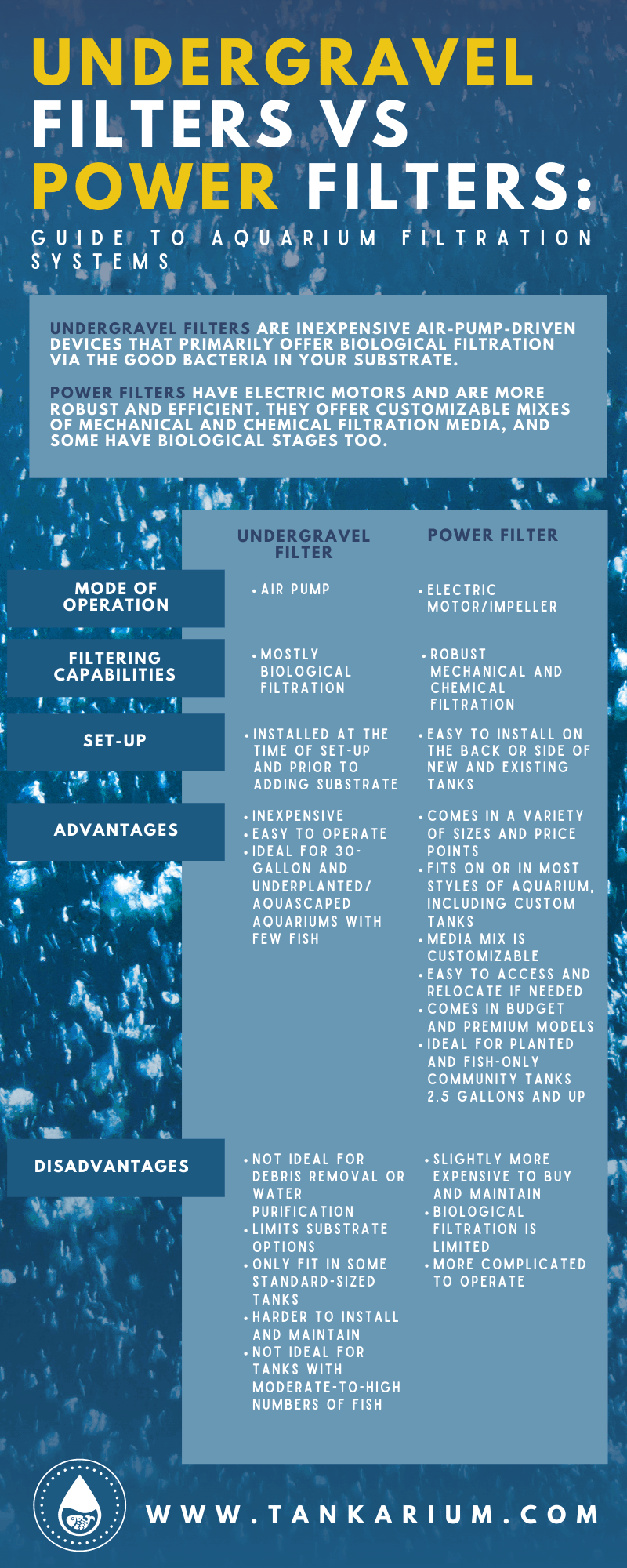
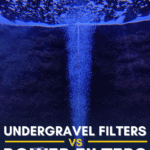
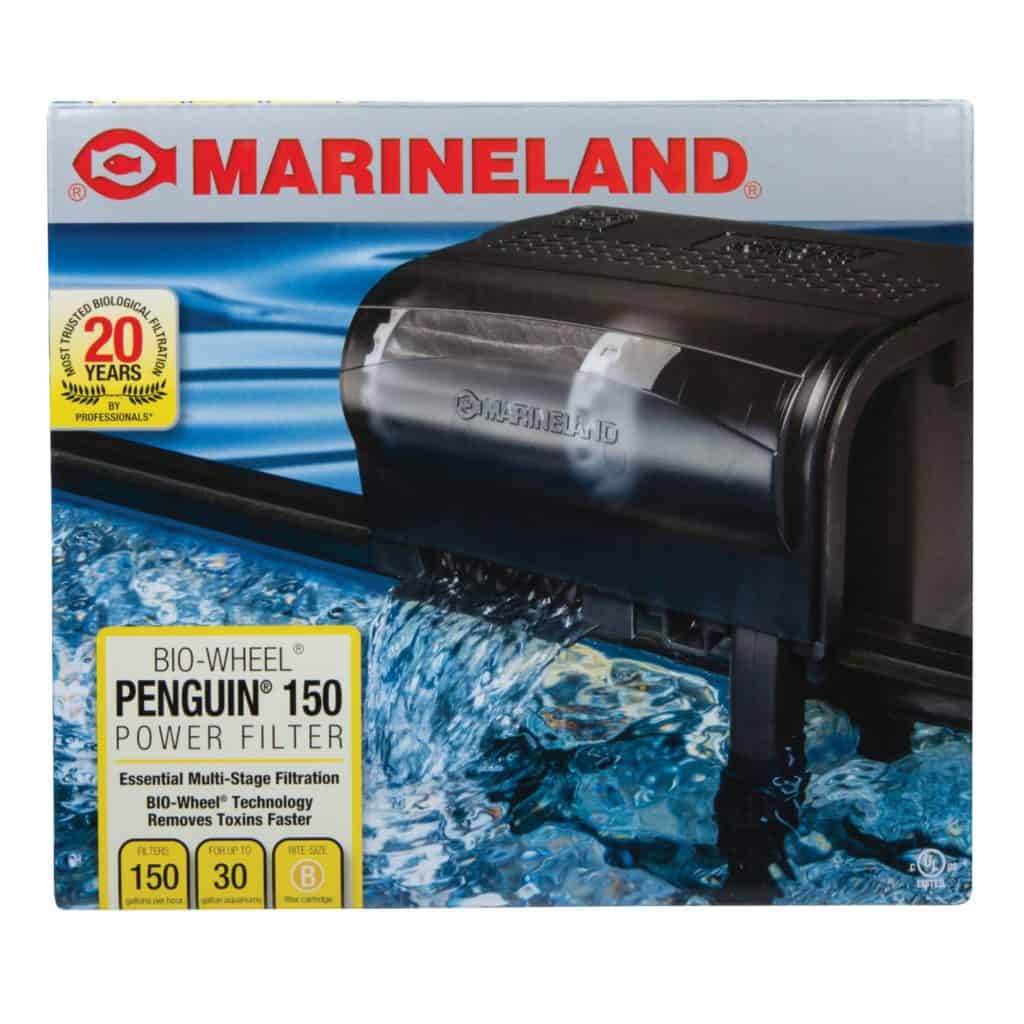
This was very informational. Thank you for taking the time to explain the differences.
I really like an unddr gravel filter with low flow, like aqua clear 20 power heads. And a hob power filter. My tank always looks amazing.
It seems that for the most part people have overlooked the huge surface area that UG filters provide even when only placed in one corner of the tank and relatively the biological filtration capacity they provide is far higher than a HOB or internal filter. Properly set up they keep water gin clear and biologically safe. With the right size and type of gravel they provide fantastic mechanical filtration ability too. As for chemical filtration, the best method of keeping dissolved organics down is water changes, not carbon, and which you would do regardless of filter type. And most would do so at the same time as vacuuming the substrate so that would not be an additional chore just because you opted for a UGF. An Eheim canister filter would set you back hundreds of pounds, an UGF with air pump, air stone and tubing about no more than £30.00. Both achieve the same level of water purification and both would need you do weekly water changes and substrate vacuuming… only one would break the bank though!
I have one of those top of the range canister filter and although my tank is doing fine, I always wanted to go back to UG filter like I used to have on and off in the last 30 years. I can see how inexpensive it is(my cannister costs hundreds), bio filtration is through the roof and redundancy is great. Maybe I will combine both or sell that expensive canister. Choices, choices.